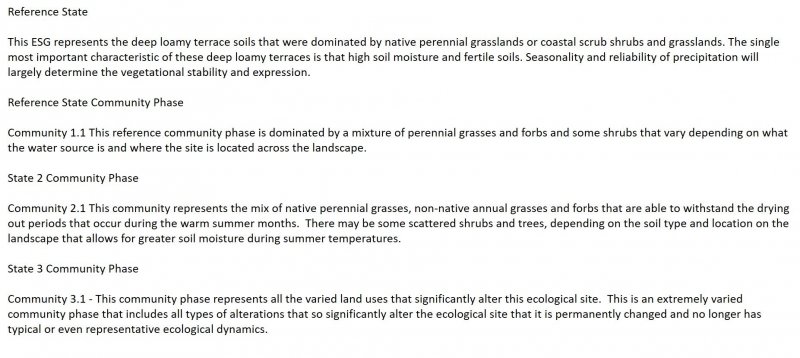Ecological site group R014XG912CA
Loamy Terrace
Last updated: 09/07/2023
Accessed: 12/22/2025
Ecological site group description
Key Characteristics
None specified
Provisional. A provisional ecological site description has undergone quality control and quality assurance review. It contains a working state and transition model and enough information to identify the ecological site.
Physiography
This ESG is typically found on alluvial and marine terraces and some low-lying uplands. Slopes typically range from 0 to 50% and elevations vary from sea level to 3000 ft.
Climate
The average annual precipitation in this area is 11 to 53 inches (272 to 1,353 millimeters). The higher amounts of precipitation occur at the higher elevations in the area north of San Francisco. Most of the rainfall occurs as low- or moderate-intensity, Pacific frontal storms during winter. This area is very dry from mid-spring to mid-autumn. Snowfall is rare. The average annual temperature is 54 to 61 degrees F (12 to 16 degrees C). The freeze-free period averages 315 days and ranges from 265 to 365 days. It is longest near the coast, and it becomes shorter with elevation.
Soil features
Soils in this ESG are extremely varied and consists of deep to very deep, well drained to somewhat poorly drained soils that formed primarily in alluvium. The soils typically are fine sandy loams, loams and gravelly loams, with a subsurface argillic horizon. They are good soils for agriculture and thus significant acres have been converted to irrigated and non-irrigated croplands such as vineyards, orchards, artichokes, strawberries, and brussel sprouts.
Some representative soils include:
Colma, a fine-loamy, mixed, superactive, mesic Typic Argixeroll
Elkhorn, a fine-loamy, mixed, superactive, thermic Pachic Argixeroll
Huichica, a fine-loamy, mixed, superactive, thermic Abruptic Haplic Durixeralf
Pinole, a fine-loamy, mixed, active, thermic Ultic Argixeroll
Redvine, a fine, mixed, semiactive, thermic Ultic Palexeralf
Watsonville, a fine, smectitic, thermic Xeric Argialboll
Vegetation dynamics
This ESG covers the areas of the valleys in MLRA 14 that were at one time part of a vast complex of coastal prairies, meadows, and native grasslands with scattered shrubs and oaks. The urbanized landscape in the valleys within this MLRA that exists today makes it difficult to imagine the natural landscape prior to human development.
These loamy terraces were likely the loamy-textured areas that received significant spring water run-on from upslope watershed water or along coastline marine terraces that stayed well-watered throughout the year. Once the area began to be settled, many of these highly fertile and productive ecosystems were drained, leveed, cleared for crops and other agriculture, and urbanized.
As this landscape was de-watered and houses and agriculture took over, the water table for many of these habitats moved deeper and deeper, creating soils that would no longer offer the available soil moisture for many of the plants that had evolved with the hydrologic function of the natural system that no longer existed. These loamy terracess may have remained wetter than many of the surrounding soils, due to their prolonged available water capacity and their argillic horizons that perched water for a time before moving off site or deep into the aquifers on the landscape. The variable range in soil textures will dictate the species composition and production, with the finer soils holding more water that results in more native perennials and forbs and higher annual production overall. The coarser textures will dry out more rapidly through both drainage and evapotranspiration in the summer months making them less hospitable for many of the native perennial grasses and more dominated by annual grasses and forbs. Annual production will still be higher than the other ESGs on terraces and uplands, due to the deep, loamy soils which provide decent available water and slightly slower but still well drained soil conditions.
Historically, this site may have looked similar to the CWHR native perennial grasslands or coastal prairies or coastal scrublands, however with the introduction of non-native annual grasses and the impacts from fragmentation, extensive agriculture, continued de-watering, and human alterations such as homes and roads, this site now reflects a lower producing, dry, annual grassland.
Currently, where this site is not under cultivation or urban developments, it is dominated by non-native annual grasses and possibly some scattered shrubs and occasional valley oak trees. These include wild oats, soft chess, ripgut brome, red brome, wild barley, and foxtail fescue. Common forbs include broadleaf filaree, redstem filaree, turkey mullein, true clovers, bur clover, popcorn flower, and many others. Perennial grasses will be found in moist, lightly grazed, or relic prairie areas. Species composition is also related to water availability with greater amounts of relic perennial grasses in areas of greater precipitation or soil moisture.
Information from:
John G. Kie
California Wildlife Habitat Relationships System
California Department of Fish and Game
California Interagency Wildlife Task Group
Major Land Resource Area
MLRA 014X
Central California Coastal Valleys
Stage
Provisional
Click on box and path labels to scroll to the respective text.


